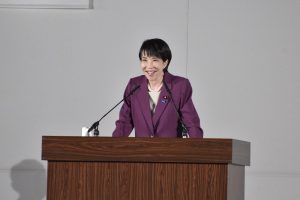On October 4, Sanae Takaichi was chosen as the new leader of Japan’s long-ruling Liberal Democratic Party (LDP). Although the LDP-led coalition government lacks a majority in both chambers of parliament, a fractured opposition makes Takaichi’s election as the nation’s first female prime minister all but certain – a development widely reported by global media as “breaking the glass ceiling.”
This marks a significant milestone in a country that ranked 118th out of 148 in this year’s Global Gender Gap Index issued by the World Economic Forum. Japanese women are nearly equal to their male counterparts with regard to health and educational attainment, but lag far behind when it comes to political empowerment. Female MPs currently comprise 16 percent of the House of Representatives (the Diet’s lower house) – a record high for Japan but still lower than most other advanced and many developing nations.
Under any circumstances, it would be simplistic to expect a female head of government to facilitate greater gender equality in a society long dominated by patriarchal norms. However, incoming prime minister Takaichi is well-known for her socially conservative views, including on gender issues, as well as a nationalistic stance.
Citing the desirability of upholding traditional family values, Takaichi made clear her opposition to legalizing same-sex marriage and amending existing laws that bar married couples from having different surnames. She is also adamant that only males should remain eligible to inherit the imperial throne, calling this tradition “an important treasure unique to Japan.” It was no coincidence that, during the LDP leadership campaign, she did not emphasize the historic nature of Japan selecting a female prime minister.
More broadly, the recent increase in the proportion of female legislators does not equate to greater support for more progressive gender-related policies.
A record number of female candidates won seats in the July 2025 House of Councillors (upper house) election, so that women now make up nearly 30 percent of the chamber. Yet candidates in the upper house election who supported or somewhat supported allowing married couples to maintain separate surnames – an issue long emblematic of women’s rights in Japan – decreased from 53.6 percent in 2022 to 52 percent in 2025, according to an analysis of the UTokyo-Asahi Surveys. The same trend is true with respect to support for same-sex marriage, which decreased from 46.4 percent to 44 percent, and increasing the number of immigrants, which decreased significantly from 58.4 percent to 38.4 percent.
While the 2024 lower house election also showed a decline in support for increased immigration, it maintained its progressive momentum for the support for separate surnames and same-sex marriage.
Descriptive representation by itself can serve as a powerful symbol, and Takaichi has promised to appoint more women to her Cabinet than her predecessors – “not particularly lower than that of Nordic countries.” Yet as demonstrated by examples from elsewhere in Asia, such as Indonesia and South Korea, having a female top executive does not necessarily help raise the status of women in general and specifically their political empowerment. What is required are greater numbers of legislators – male and female alike – who are committed to drafting and implementing policies designed to promote gender equality, particularly on political empowerment and to address issues such as work-life balance, harassment, and persistent gender stereotypes.



























